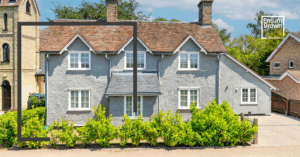As Ware First-Time Buyers are Being Locked Out of the Ware Property Market – Rents Have Risen by 3.9%
With the banks reducing the number of low deposit mortgages (i.e. deposit of 10% and below) since Covid-19 hit in the spring, this has meant that the number of Ware first-time buyers has been decreasing quickly, meaning many of those would-be Ware buyers wanting to make the first step on the Ware property ladder will stay in the Ware rental sector.
This has caused demand to grow amongst Ware renters for larger homes to ride out Covid, as they hunker down for the long haul to wait for normality to return to the property market. This has caused …
Ware rents to rise from £964 to the current £1,002 per month
over the last 12 months, an increase of 3.9%.
Interestingly, the opposite is happening in Central London, where the rents tenants are having to pay have dropped by 3.8% in the last 12 months, as demand has dropped like a stone. It appears Central London tenants are looking to move out to the suburbs, in search of bigger homes, gardens and green open spaces. For example, the average rent for a 1-bed apartment in St. John’s Wood currently stands at a very reasonable £1,817 per month whilst a 2-bed apartment in Kensington and Chelsea is currently at an average bargain rent of £3,715 per month (yes, they might be low compared to last year, yet for us in Ware, that still seems like a lot of money!). Also, there has been further downward pressure on Central London rents, as many Airbnb landlords have dumped their short-term holiday let properties onto the long-term rental market as the tourism in the capital has dwindled because of the pandemic.
This has been the sharpest drop in Central London rents since the summer of 2009, when the property market was still stumbling from the Credit Crunch.
This means there is a reverse of the trend of the 2010’s (2010 to 2018 to be exact), when initially the London property market was shooting up whilst the rest of the country was in the doldrums. When the rest of the UK did start to rise slowly in 2013, London kicked on even further like a rocket … yet now it appears the opposite is happening.
Getting back to Ware, according to the Land Registry, property values currently stand 4.1% higher than a year ago, this is split down as follows:
- Detached Ware homes 4.5% higher
- Semi-detached Ware homes 5.4% higher
- Townhouse / terraced Ware homes 4.5% higher
- Ware apartments / flats 1.4% higher
Yet, do remember, these figures do NOT take into account the prices paid by desperate Ware buyers this summer, often paying top dollar to secure the property. This will only filter through in the figures released in the spring.
So, why are the banks curtailing the number of low deposit mortgages, meaning that first-time buyers must find a much larger down payment before they are able to buy their first Ware property?
The reason is the banks are fearful of a house price crash in 2021 (although if you recall I wrote about that a few weeks ago and the reasons why that is less likely to happen). They too are afraid of the frothy nature of the property market since the end of the first lockdown in late spring. The bank is lending its own money to buyers and no mortgage lender wants to be holding an enormous amount of these types of high percentage mortgages if house prices fall in 2021, because the bank would be saddled with negative equity and repossession on their hands (and we all know what that did to the housing market in the late 1980’s and early 1990’s as repossessions rocketed).
This can quite clearly be seen in the pricing and availability of low deposit mortgages. As the Bank of England has reduced its base rate to 0.1%, in the last 12 months 10% deposit mortgages rates have actually increased from 2% to 2.8%. Also, when lenders have been offering 10% mortgages throughout the summer, borrowers have had only a 24-hour window to commit before the lender withdraws the mortgage product from the market because of over subscription. As with all economics, if demand is greater than supply, the price goes up. That extra 0.8% doesn’t sound a lot until you realise a first-time buyer would have to pay an additional £167 per month in interest payments on a 10% deposit mortgage, assuming they borrowed £250,000.
However, it’s not all doom and gloom for first-time buyers as there are embryonic signs that the 10% deposit mortgage market could gradually be returning to normal, as I have recently heard some lenders are taking up to a week for their 10% deposit mortgage offers to run out. Fingers crossed!
So, what does this all mean for Ware landlords? Those Ware landlords with properties with gardens and larger rooms will be seeing increased demand. The ability to have pets in the rental property is also an advantage, and depending on the property, can add a decent premium to the rent that can be charged.
One final thought though for all homebuyers in Ware, be aware it’s going to be very challenging to get your house purchase through in time to meet the 31st March 2021 stamp duty holiday cut off if you are starting the process in November. Make sure your lender and solicitor have the capacity to meet that deadline and when you are asked for information, you drop everything to provide it. The odd day delay here and there will mean the difference between you getting the keys for your new Ware home before the end of March 2021 and saving thousands of pounds in Stamp Duty Tax … or feeling a fool from the 1st of April 2021 and having to pay the tax!





